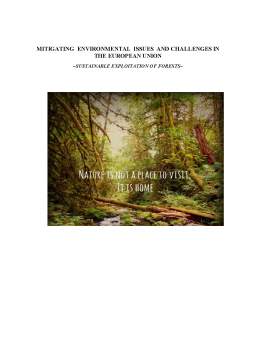Extras din referat
Introduction
”What we are doing to the forests of the world is but a mirror reflection of what we are doing to ourselves and to one another”
Mahatma Gandhi
Despite international efforts to save forests, global damage continues. Recent studies have shown that deforestation is steadily increasing and sustainable forest management is avoided.
This situation impose an international need for an institutional, political framework to support the efforts of countries to manage and conserve forests for a long time. Taking into account the primary impact of policy decisions and actions on forests, the international actions that exists have little use in the effort to promote sustainable forests development.
Globally, the phenomenon of deforestation and forest degradation does not show signs of stopping.
The Food and Agriculture Organization of the United Nations and the United Nations Economic Commission for Europe have recently published several reports on changes in the size of forest areas. According to data released by The Food and Agriculture Organization of the United Nations, over the past decade, 15.4 million hectares of forests have disappeared on average each year. Analysts of this study said that forest deforestation would have the biggest impact on biodiversity. Besides deforestation, also the rest of forest resources are affected, they have undergone strong pressures in recent years. Forest exploitation activities have increased, and new tree plantations have failed to keep pace with deforestation. In the 1990s, for example, an average of six hectares of forests was grubbed up for each planted tree.
The World Conservation Monitoring Center believes that the biggest problem this phenomenon represents is the loss of habitat, with the greatest impact on biodiversity. Degradation and fragmentation of forests diminish biological diversity. Removing certain plant and animal species, may affect the life cycle of others. Undoubtedly, many plant and animal populations can not live for a long time in a fragmented habitat. In addition, deforestation is behind the annual loss of 2,5 gigatons of biomass above ground.
There is no way we can underestimate the importance of forests. The forests provide the indispensable basic needs for our survival, from the air we breathe to the woods we use. Besidesbeing a home for animals and humans, forests also prevent soil erosion, offer watershed protection and diminish climate change. Yet, although we understand how much we depend on forests, we are still allowing them to vanish.
The studies in the field bring to our attention the following data:
- ”about 30% of the world’s land surface is forest;
- over 2 billion people rely on forests for shelter, livelihoods, water, food and fuel security;
- 300 million people live in forests, including 60 million indigenous people;
- more than 13 million people across the world are employed in the formal forest sector.”
On a global scale, the world lost around 129 million ha of forest, between 1990 and 2015. This led to irreversible changes in the ecosystem of our planet. It is important to understand that by taking away forests, we determine the entire ecosystem of the planet to fall apart; thus, the conservation and the sustainable exploitation of forests is a current priority for the entire world.
Focusing on the territory of the European Union it is known that “forests and other wooded land cover over 40% of the EU’s land area, with a great diversity of character across regions. Afforestation and natural succession have increased the EU’s forest area by around 0.4% per year over recent decades. Globally, however, forest area continues to decrease.”
In case of Romania, forests do not only play biological, ecological and environmental roles. Expanding over a surface of 6 249 million ha, forests represent 26.3% of Romania’s land area, contributing to economic and social growth. This nation also has tight roots with its forests concerning country’s historical and cultural development; thus, taking care of the forests is not only a matter of necessity in the modern world that is facing different environmental challenges, it is also a matter of being thankful and appreciative for all the natural capital this country has on its territory.
As mentioned previously, forests cover more than 40% of the European Union’s land area, with 60% of them being owned by private owners, and the remainder belonging to the state and public owners. The EU vision is that forests are playing a multifunctional role, serving to social, economic and environmental purposes. Although the forests are often underestimated, on a socio-economic base, they contribute to the development of rural areas and the supply of jobs for millions. About half of the EU’s total renewable energy consumption is represented by forest biomass. In these terms, it is essential to ensure the sustainable forest management, in order to harvest all the benefits the forest can give as without diminishing the possibilities of the future. The proper definition for sustainable forest management was given during the Ministerial Conference on the Protection of Forests in Europe, held in Helsinki, 1993:
Bibliografie
Food and Agriculture Organization of the United Nations (FAO), Forest Resources Assessment, 1990: Tropical Countries, FAO Forestry Paper 112 (Rome: FAO, 1993)
United Nations Economic Commission for Europe (UN-ECE), Food and Agriculture Organization (FAO), The Forest Resources of the Temperate Zones: Main Findings of the UN-ECE/FAO 1990 Forest Resource Assessment (New York: UN, 1992)
Derek Denninston, "Air Pollution Damaging Forests," Lester R. Brown, et al eds. in Vital Signs (New York: W.W. Norton, 1993), 108
http://eur-lex.europa.eu/resource.html?uri=cellar:21b27c38-21fb-11e3-8d1c-01aa75ed71a1.0022.01/DOC_1&format=PDF
http://wwf.panda.org/about_our_earth/deforestation/importance_forests/
http://eur-lex.europa.eu/resource.html?uri=cellar:21b27c38-21fb-11e3-8d1c-01aa75ed71a1.0022.01/DOC_1&format=PDF
http://www.fao.org/docrep/w3722E/w3722e23.htm
http://www.fao.org/docrep/w3722E/w3722e23.htm
Preview document
Conținut arhivă zip
- Mitigating environmental issues and challenges in the European Union - sustainable exploitation of forests.docx








